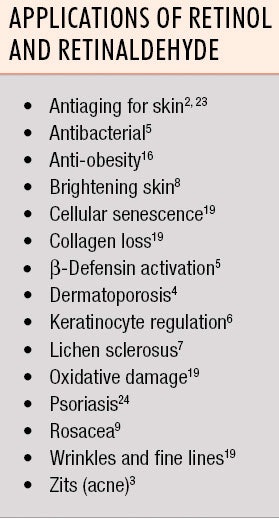
Retinaldehyde, in conjunction with complementary treatments that include chemical peels, dermabrasion and lasers, can provide a wide-spectrum skin care arsenal to estheticians, dermatologists and consumers, offering multifaceted attributes (see Applications sidebar).1 These benefits are reviewed here, along with mechanisms to deliver such effects.
Retinoids and Retinaldehyde: From Anti-aging to Zits
Retinoids are compounds that affect the body in ways similar to vitamin A.13 In broader terms, they are any of a group of compounds providing the same biological benefits as vitamin A. The chemical structures of select retinoids and compounds having the biological activity of retinoids are illustrated in Figure 1. In fact, β-carotene is converted into retinaldehyde by the body, which is further processed to form vitamin A (see Figure 2).26
Retinoids have found application in the treatment of both chronological and photo-aging.2 Additionally, they are potent therapeutic agents used topically and systemically as anti-acne agents.3
Repair and defend: In relation, retinaldehyde effectively treats dermatoporosis—a chronic, cutaneous insufficiency/fragility syndrome characterized by extreme skin atrophy.4 Furthermore, topical retinaldehyde has been found to induce β-defensin-3 expression, which is implicated in the resistance of epithelial surfaces to microbial colonization; thus, it acts as an antibacterial agent.5
Retinaldehyde and retinol have also been reported as regulators of gene expression in keratinocytes. Keratinocyte proliferation and hyaluronan synthesis are believed to be partly mediated through the heparin-binding EGF-like growth factor (HB-EGF) activated EGFR pathway.6 Retinaldehyde has been shown to increase the expression of HB-EGF and involucrin (IVL) greater than retinol, reducing the appearance of aged skin.7
Another application for retinaldehyde is the topical treatment of Lichen sclerosus,8 an uncommon chronic dermatosis that can occur on the anogenital area in perimenopausal women.
Skin depigmenting: Retinoids have been reported to exert skin-depigmenting activity as well, but unlike most depigmenting agents that target tyrosinase, retinoids are not phenolic and may act via different mechanisms.9 Although retinoids show promise in the treatment of skin aging, irritant reactions such as burning, scaling or dermatitis have been associated with some of these therapies, thus limiting their acceptance by patients.2
Rosacea: Topical retinoids have also been used to treat rosacea. Retinoic acid, for example, has beneficial effects on the vascular component of rosacea but treatment has drawbacks, including the delayed onset of efficacy and development of skin dryness, erythema, burning and stinging. A higher tolerance in photo-damaged skin was shown with retinaldehyde versus retinoic acid, with similar efficacy, which makes retinaldehyde more suited for sensitive, irritated skin in conditions such as rosacea and red face syndrome.10 As such, a combination of retinaldehyde with the anti-inflammatory agents dextran sulfate and hesperidin methyl chalcone has thus been reported.10
Irritation Potential
To evaluate the skin metabolism of retinoids employed in the treatment of skin disorders and predict their potential irritation, MetaSite was developed. This tool is based on a computational approach to assess metabolic transformations related to cytochrome and flavin-containing monooxygenase mediated reactions. It therefore can project retinol behavior.11
In general, topical retinoic acid precursors such as retinaldehyde or retinol are less irritating than acidic retinoids.12 All-trans retinaldehyde is the most commonly used, although retinaldehyde is increasingly gaining favor, possibly due to consumer concerns over the perceived retinoid-related skin irritation.
New topical delivery systems also are being developed to circumvent skin irritation-related issues. Recent discoveries bring new life into this age-old ingredient for alleviating select topical disorders.
Nanoparticles to Trojan Horses: Delivering Retinoids
Nanoparticles have shown good potential in improving the stability, tolerability and efficacy of retinoids.14 However, they have recently become less favorable due to concerns over potential safety issues.
Additional approaches to retinoid delivery include certain Schiff’s bases with polylysine, and retinaldehyde-hyaluronic acid fragments.15 Liposomes of retinaldehyde and other retinoids also have been reported;16 indeed, one system to deliver retinaldehyde for treating obesity has been patented.17
Various emulsion-based delivery systems for retinaldehyde and other retinoids have been reported, too,18 as well as encapsulated retinaldehyde formulated in a gel-based system.19
In addition, a Trojan horse delivery system, known as a retinaldehyde γ-cyclodextrin complex (RCC), was developed to expand retinaldehyde’s application in cosmetics by releasing it in a controlled manner. RCC is developed from the reaction of a polyene aldehyde such as retinaldehyde, with a cyclodextrin; in this case, γ-cyclodextrin.21
Gene expression data confirmed that retinaldehyde delivery via this approach effectively treated many of the skin symptoms for which retinaldehyde was noted above, in addition to: oxidative damage; inflammation; the loss of cell adhesion, desquamation, keratinization and skin barrier function; cellular senescence; and topical wounds.20
Combinatorial Therapies
Combinations of retinoids with other agents to provide greater efficacy and reduced skin irritation are receiving renewed interest for dermatological applications.
Skin whitening, acne and anti-aging: For example, the combination of retinaldehyde or tretinoin with other skin depigmenting agents has been shown to significantly improve the depigmentation of solar lentigines.22 Retinaldehyde in combination with glycolic acid also has been reported to treat mild to moderate acne during sun exposure and with good skin tolerability.23 Also, glycylglycine oleamide, a peptide derivative reported to protect connective tissue from glycation and elastosis, has been combined with retinaldehyde to treat skin aging.24
Psoriasis: Furthermore, elevated levels of Epidermal Retinol Dehydrogenase 2 (RDH2) have been found in psoriatic skin, and the potential role of RDH2 in the oxidation of retinol to retinaldehyde for retinoic acid biosynthesis in human keratinocytes has been acknowledged. In fact, 11-cis-retinoic acid in particular, an oxidation product of 11-cis-retinaldehyde, has found applications in the treatment of psoriasis.25
Conclusion
As this review indicates, retinaldehyde offers a less irritating alternative to retinoids for a wide array of skin care products. In relation, a new delivery system based on a γ-cyclodextrin provides multifunctional benefits to cosmetics using stabilized retinaldehyde.
References
- Hubbard et al., Reversal of skin aging with topical retinoids, Plast Reconstr Surg 133(4) 481e-90e (Apr 2014) doi: 10.1097/PRS.0000000000000043; Rivas et al., Treatment of melasma with topical agents, peels and lasers: An evidence-based review, Am J Clin Dermatol14(5) 359-76 (Oct 2013) doi: 10.1007/s40257-013-0038-4; Souza et al., Single-session intense pulsed light combined with stable fixed-dose triple combination topical therapy for the treatment of refractory melasma, Dermatol Ther 25(5) 477-80 (Sep-Oct 2012) doi: 10.1111/j.1529-8019.2012.01530.x
- Mukherjee et al., Retinoids in the treatment of skin aging: An overview of clinical efficacy and safety, Clin Interv Aging 1(4) 327-48 (2006); Darlenski et al., Topical retinoids in the management of photodamaged skin: From theory to evidence-based practical approach, Br J Dermatol163(6) 1157-65 (Dec 2010) doi: 10.1111/j.1365-2133.2010.09936.x; Babamiri et al., Cosmeceuticals: The evidence behind the retinoid, Aesthet Surg J 30(1) 74-7 (Jan 2010) doi: 10.1177/1090820X09360704; Ianhez et al, Retinoids for prevention and treatment of actinic keratosis, An Bras Dermatol 88(4) 585-93 (Jul-Aug 2013) doi: 10.1590/abd1806-4841.20131803; Thielitz et al., Topical retinoids in acne—An evidence-based overview, J Dtsch Dermatol Ges 8 suppl 1 S15-23 (Mar 2010); Baudier, Composition for reducing skin aging disorders comprising a retinaldehyde and a Leontopodium alpinum extract, WO2015082520 (A1) (Jun 11, 2015); Stratigos et al, The role of topical retinoids in the treatment of photoaging, Drugs 65(8) 1061-72 (2005)
- Dall’Oglio et al, Cosmetics for acne: Indications and recommendations for an evidence-based approach, G Ital Dermatol Venereol 150(1) 1-11 (Feb 2015; epub Oct 15, 2014)
- Kaya, New therapeutic targets in dermatoporosis, J Nutr Health Aging 16(4) 285-8 (Apr 2012); Nikolic et al., Hyalurosome gene regulation and dose-dependent restoration of skin atrophy by retinaldehyde and defined-size hyaluronate fragments in dermatoporosis, Dermatology 229(2) 110-5 (2014, epub Aug 14, 2014) doi: 10.1159/000362594
- Lee et al, Topical retinoids induce β-defensin 3 expression in mouse skin, Int J Dermatol 49(9) 1082-4 (Sep 2010) doi: 10.1111/j.1365-4632.2009.04260.x; Pechère et al, The antibacterial activity of topical retinoids: The case of retinaldehyde, Dermatology205(2) 153-8 (2002)
- Amann et al, Retinal and retinol are potential regulators of gene expression in the keratinocyte cell line HaCaT, Exp Dermatol 20(4) 373-5 (Apr 2011, epub Aug 31, 2010) doi: 10.1111/j.1600-0625.2010.01127.x; Anamm et al, Regulation of gene expression by retinoids, Curr Med Chem18(9) 1405-12 (2011); Pasonen-Seppänen et al, All-trans retinoic acid-induced hyaluronan production and hyperplasia are partly mediated by EGFR signaling in epidermal keratinocytes, J Invest Dermatol 128 797–807 (2008; epub Oct 18, 2007) doi:10.1038/sj.jid.5701098; Harris, EGFR signaling in podocytes at the root of glomerular disease, Nature Medicine 17 1188–1189 (2011) doi:10.1038/nm.2455
- Genemarkers LLC, Project Report 024-022 (Jun 6, 2013)
- Kaya et al, Restored epidermal CD44 expression in Lichen sclerosus et atrophicus and clinical improvement with topical application of retinaldehyde, Br J Dermatol152(3) 570- (Mar 2005); Wakelin et al, Lichen sclerosus in women, Clin Dermatol 15(1) 155-69 (Jan-Feb 1997)
- Sorg et al, The potential depigmenting activity of retinaldehyde, Dermatology 227(3) 231-7 (2013, epub Sep 24, 2013) doi: 10.1159/000354294; Kang et al, The role of topical retinoids in the treatment of pigmentary disorders: An evidence-based review, Am J Clin Dermatol 10(4) 251-60 (2009) doi: 10.2165/00128071-200910040-00005; Ortonne, Retinoid therapy of pigmentary disorders, Dermatol Ther 19(5) 280-8 (Sep-Oct 2006)
- Gilbert et al, Efficacy and tolerance of a topical skin care regimen as an adjunct to treatment of facial rosacea, Cosm Derm 21(9) 501 (Sep 2008)
- Słoczy’nska et al., Skin metabolism established with the use of MetaSite for selected retinoids employed in topical and systemic treatment of various skin disorders and found in cosmeceuticals, Acta Biochim Pol 62(2) 201-6 (2015, epub Apr 9, 2015) doi: 10.18388/abp.2014_891
- Sorg et al, Topical retinoids in skin aging: A focused update with reference to sun-induced epidermal vitamin A deficiency, Dermatology 228(4) 314-25 (2014, epub May 9, 2014) doi: 10.1159/000360527
- https://en.wikipedia.org/wiki/Retinoid (Accessed Nov 24, 2015)
- Gao et al, A microparticle/hydrogel combination drug-delivery system for sustained release of retinoids, Invest Ophthalmol Vis Sci 53(10) 6314-23 (Sep 19, 2012)
- Viguera et al, A water-soluble polylysine-retinaldehyde Schiff base. Stability in aqueous and nonaqueous environments, J Biol Chem 265(5) 2527-32 (Feb 15, 1990); Cordero et al, Retinaldehyde/hyaluronic acid fragments: A synergistic association for the management of skin aging, J Cosmet Dermatol 10(2) 110-7 (Jun 2011)
- Gabriel et al, Method for preparing liposomes of retinaldehyde or other precursors of retinoic acid and product thus obtained, WO 2015097317 (A1) (Jul 2, 2015)
- Plutzky et al, Retinaldehyde mimetics and inhibitors of retinaldehyde dehydrogenase in the treatment of disorders, US 2014378530 (A1) (Dec 25, 2014)
- Jenning, Retinoid-containing emulsions with continuous water phase, for topical application e.g. for skin treatment, repair or renewal, having structured, polar, viscous oil phase to stabilize active agent, DE 19946184 (A1) (Mar 29, 2001)
- Dewandre, New topical composition containing retinaldehyde, EP 0965333 (A2) (Dec 22, 1999); Dihora et al, Delivery particle, US Pat 9,186,642 (Nov 17, 2015)
- Peter et al, Topical therapies based on gene expression of novel retinaldehyde cyclodextrin complexes, J Dermatolog Clin Res 3(2) 1047 (2015); Peter et al, Retinaldehyde cyclodextrin complex for topical skin therapy, Global Dermatology (2016) submitted for publication
- Peter et al, U.S. Pat. 8,410,079; 8,859,269
- Cameli et al, Clinical and instrumental evaluation of the efficacy of a new depigmenting agent containing a combination of a retinoid, a phenolic agent and an antioxidant for the treatment of solar lentigines, Dermatology 230(4) 360-6 (2015, epub Apr 9, 2015) doi: 10.1159/000379746; Hexcel et al, Triple combination as adjuvant to cryotherapy in the treatment of solar lentigines: Investigator-blinded, randomized clinical trial, J Eur Acad Dermatol Venereol 29(1) 128-33 (Jan 2015, epub Mar 31, 2014) doi: 10.1111/jdv.12484; Questel et al, Follow-up of solar lentigo depigmentation with a retinaldehyde-based cream by clinical evaluation and calibrated color imaging, Skin Res Technol 21(2) 241-6 (May 2015, epub Jul 31, 2014) doi: 10.1111/srt.12182
- Masini et al, Combination therapy with retinaldehyde (0.1%) glycolic acid (6%) and efectiose (0.1%) in mild to moderate acne vulgaris during the period of sun exposure—Efficacy and skin tolerability, Eur Rev Med Pharmacol Sci 18(16) 2283-6 (Aug 2014); Boisnic et al, RALGA (Diacneal) decreases melanin content in a human skin model, Dermatology 210 suppl 1 35-8 (2005)
- Agnes et al, Glycylglycine oleamide in dermo-cosmetology, EP1061897 B1; Bacqueville et al, Cosmetic or dermatological compositions combining retinaldehyde and glycylglycine oleamide, and the cosmetic or dermatological uses thereof, WO2014195315 (A1) (Dec 11, 2014)
- Lee et al, Biochemical characterization of human epidermal retinol dehydrogenase 2, Chem Biol Interact 178(1-3) 182-7 (Mar 16, 2009, epub Sep 24, 2008) doi: 10.1016/j.cbi.2008.09.019; Braiman, Treatment of psoriasis with 11-cis-retinoic acid, WO9634601 (A1) (Nov 7, 1996)
- Shete et al, Mammalian metabolism of β-carotene: Gaps in knowledge, Nutrients 5(12) 4849-4868 (2013) doi:10.3390/nu5124849











